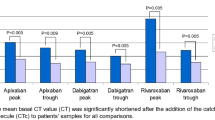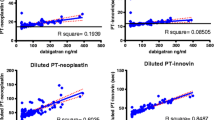Summary
Patients with intracoronary stent implantation are treated with aggressive anticoagulant and antiplatelet therapy consisting of high-dose heparin, phenprocoumon, acetylsalicylic acid, dipyridamole, and the infusion of dextran to prevent a subacute thrombotic occlusion of the stented segment. In an effort to optimize this treatment by reducing both imminent bleeding complications and subacute thrombotic occlusion, the concentrations of prothrombin fragment 1+2 (F1+2) were determined after intracoronary Palmaz-Schatz stent implantation in 19 consecutive patients. The F1+2 concentrations after stent implantation and before the initiation of oral anticoagulant therapy (OAT) were 0.35 nm/l and 0.25–0.53 nm/l (median and 25th–75th percentile), versus 0.74 nm/l and 0.52–0.78 nm/l, in healthy subjects and 0.61 nm/l and 0.30–1.02 nm/l in 15 patients with ongoing proximal DVT. Nine days after initiation of OAT, F1+2 concentrations in both patient groups had not yet reached levels observed in patients with OAT in the stable state (0.16 nm/l, 0.12–0.26 nm/l;n=76;P<0.0001 compared with healthy subjects; INR 2.0–4.5). Despite an INR greater than 2.0, accompanying heparinization was terminated on day 9. In two stented patients a minor bleeding complication arose after the removal of the arterial catheter. Subacute thrombotic occlusions were not observed. Since F1+2 concentrations did not exceed the upper limit of normal range (1.11 nm/l) in any of the 19 patients, the therapeutic regimen was not changed. Monitoring F1+2 may thus be helpful in introducing a more individual treatment if aggressive anticoagulation has to be performed.
Similar content being viewed by others
References
Bauer KA, Rosenberg RD (1987) The pathophysiology of the prethrombotic state in humans: insights gained from studies using markers of hemostatic system activation. Blood 70: 343–350
Bauer KA, Broekmans AW, Bertina RM, Conrad J, Horellou MH, Samama MM, Rosenberg RD (1988) Hemostatic enzyme generation in the blood of patients with hereditary protein-C deficiency. Blood 71: 1418–1426
Conway EM, Bauer KA, Barzegar S, Rosenberg RD (1987) Suppression of hemostatic system activation by oral anticoagulants in the blood of patients with thrombotic diatheses. J Clin Invest 80: 1535–1544
Cowley MJ, Dorros A, Kelsey SF, Van Raden M, Detre KM (1984) Acute coronary complications associated with percutaneous transluminal angioplasty. Am J Cardiol 53: 12C-16C
Ellis SG, Roubin GS, King SB, Douglas JS, Weintraum WS, Thomas RG, Cox WR (1988) Angiographic and clinical predictors of acute closure after native vessel coronary angioplasty. Circulation 77: 372–379
Erbel R, Schatz R, Dietz U, Nixdorff U, Haude M, Aichinger S, Pop T, Meyer J (1989) Ballondilatation und koronare GefÄ\stützenimplantation. Z Kardiol 78: 71–77
Francis CW, Marder VJ, Evarts CM, Yaukoolbodi S (1983) Two-step warfarin therapy: prevention of postoperative venous thrombosis without excessive bleeding. JAMA 249: 374–378
Haude M, Erbel R, Straub U, Dietz U, Schatz R, Meyer J (1991) Results of intracoronary stents for management of coronary dissection after balloon angioplasty. Am J Cardiol 67: 691–696
Holmes DR, Vliestra RE, Smith HC, Vetrovec GW, Cowley MJ, Faxon DP, Gruentzig AR, Kelsey SF, Detre KM, Van Raden MJ, Mock MB (1984) Restenosis after percutaneous transluminal coronary angioplasty (PTCA): a report from the PTCA registry of the National Heart, Lung, and Blood Institute. Am J Cardiol 53: 77C-81C
Hull R, Hirsh J, Jay R, Carter C, England C, Gent M, Turpie AGG, McLoughlin D, Dodd P, Thomas M, Raskob G, Ockelnford P (1982) Different intensities of anticoagulation in the long-term treatment of proximal vein thrombosis. N Engl J Med 307: 1676–1681
Loeliger EA (1985) Laboratory control, optimal therapeutic ranges and therapeutic quality control in oral anticoagulation. Acta Haematol 74: 125–131
Ma Xi, Beguin S, Hemker HC (1989) The relative importance of the factors II, VII, IX and X for the prothrombinase activity in plasma of orally anticoagulated patients. Thromb Haemost 62: 788–791
Mannucci PM, Bottasso B, Tripodi A, Bianchi Bonomi A (1991) Prothrombin fragment 1+2 and intensity of treatment with oral anticoagulants (Letter). Thromb Haemost 66: 741
Palmaz JC, Sibbitt RR, Tio FO, Reuter SR, Peters JE, Garcia F (1986) Expandable intraluminal vascular graft: a feasibility study. Surgery 99: 199–205
Pelzer H, Schwarz A, Stüber W (1991) Determination of human prothrombin activation fragment 1+2 in plasma with an antibody against a synthetic peptide. Thromb Haemost 65: 153–159
Poller L (1987) Progress in standardization in anticoagulant control. Hematol Rev 1: 225–241
Poller L (1987) Oral anticoagulant therapy. In: Bloom AL, Thomas DP (eds) Haemostasis and thrombosis. Churchill Livingstone, New York, pp 970–885
Schatz RA (1989) A view of vascular stents. Circulation 79: 445–457
Schatz RA, Palmaz JC, Tio FO, Garcia F, Garcia O, Reuter SR (1987) Balloon-expandable intracoronary stents in the adult dog. Circulation 76: 450–457
Serruys PW, Luijten HE, Beatt KJ, Geuskews R, De Feyter PJ, Van den Brand M, Reiber JHC, Tewkaten HJ, Vanes GA, Hugenholtz PG (1988) Incidence of restenosis after successful coronary angioplasty: a time-related phenomenon. Circulation 77: 361–371
Sigwart U, Puel J, Mirkovitch V, Joffre F, Kappenberger L (1987) Intravascular stents to prevent occlusion and restenosis after transluminal angioplasty. N Engl J Med 316: 701–706
Swars H, Hafner G, Erbel R, Ehrenthal W, Rupprecht HJ, Prellwitz W, Meyer J (1991) Prothrombin fragments and thrombotic occlusion of coronary stents (Letter). Lancet 337: 59–60
Teitel JM, Bauer KA, Lau HK, Rosenberg RD (1982) Studies of the prothrombin activation pathway utilizing radioimmunoassays for the F2/F1+2 fragment and thrombin-antithrombin III complex. Blood 59: 1086–1097
Thomson J (1980) Hereditary coagulation disorders, laboratory techniques. In: Thomson J (ed) Blood coagulation and haemostasis. Churchill Livingston, Edinburgh, pp 117–157
Author information
Authors and Affiliations
Rights and permissions
About this article
Cite this article
Hafner, G., Swars, H., Erbel, R. et al. Monitoring prothrombin fragment 1+2 during initiation of oral anticoagulant therapy after intracoronary stenting. Ann Hematol 65, 83–87 (1992). https://doi.org/10.1007/BF01698135
Received:
Accepted:
Issue Date:
DOI: https://doi.org/10.1007/BF01698135




